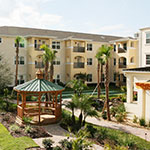Chuck Carlise sees Phoenix as a “boom or bust town”—that is, it’s either bursting at the seams with new building projects or failing to do anything new at all. In the wake of the country’s economic free fall in 2008, the city has been mired in “bust” mode, but Carlise, the president of De Rito Partners, Inc., now thinks it’s ready to roll back to “boom”—even if his fellow developers don’t. In fact, their doubt actually suits him just fine, for De Rito has been doing business against the grain for years.
No Food Deserts in the Desert
With building at a virtual standstill since 2008, even the more optimistic businesses such as De Rito Land Development (a new entity for De Rito Partners) are taking a careful approach as they work their way back from the brink.
A number of 50- to 75-acre power centers anchored by Target and similar stores have saturated the Phoenix market, according to De Rito president Jerry Friedman, and more are on the way. So, De Rito has instead turned its attention to grocery-anchored centers and small neighborhood centers, which will feed the growing populations in both Phoenix and Las Vegas (another area of interest for the company).
“It depends upon what grocer you talk to, but they’re really selling to a very localized area; maybe a one- or two-mile area is their primary market,” Friedman says. “In Phoenix, as you see growth in all directions, they have a lot of grocers. And yet you still see new ones trying to get in!” He points to WinCo Foods and WalMart Neighborhood Markets as two recent additions to the local competition.
Between Phoenix and Las Vegas, Friedman hopes to identify 10–15 sites total spanning 10–18 acres each, and from there his teams will slowly start developing the lots as grocery-anchored neighborhood centers.
“[Developers] tend to do the ‘if we build it, they will come’ thing, right?” Carlise says. “Well, we don’t do that. We lease it first. Then we build it. There’s a lot less risk that way.”
When it came to De Rito’s development of the Pavilions at Talking Stick—a renovation of the former Scottsdale Pavilions—some of the risk was easy to assess. Overgrown landscaping, an outdated paint job, and 350 light fixtures out of commission told the story of a late-1980s megamall that had fallen on hard times. “It was where families came to shop, teens came to see movies, and kids came to play miniature golf; it was never without a crowd,” recalls Molly Kaufman from Safeguard, which provided fire-suppression equipment and expertise to the Pavilions renovation. “As a native of Scottsdale, I watched the Pavilions’ unfortunate downfall and, like many residents, was deeply disappointed at what became of it.”
“There was a sweet and sour aspect to it,” Carlise says of De Rito’s Pavilions purchase. “You’d look at it and think about the way it’s going to benefit you—then you think, ‘Wait a second. It’s 140 acres, and it’s virtually in Scottsdale, on the freeway. How many public properties are there like that? Zero!’ So, from a location perspective alone, the property had a tremendous amount of value.”
The property is actually part of the Salt River Pima Maricopa Indian Community—an important fact that De Rito chose to acknowledge early on when renaming the facility. “Talking Stick is the name that [the tribe has] given a casino, a 15-story high-rise hotel, a golf course, and a stadium—we just thought the old name was inappropriate, so we renamed it the Pavilions at Talking Stick,” Carlise says. “It was a way to show the tribe [that] we understand we are part of the community.”
Looking to keep in step with the nearby top-flight Talking Stick destinations, De Rito revitalized the Pavilions with $21 million worth of renovations and tenant improvements, including improved landscaping, pedestrian access, parking, and an all-new food court. To address aging fire-safety equipment, De Rito partnered with Safeguard, Arizona’s largest provider of integrated-technology solutions. “Upon meeting with Mr. Carlise, it became clear that De Rito was not simply looking for a vendor to satisfy the Pavilions’ monthly fire monitoring and annual fire and sprinkler inspection needs,” Kaufman says. “They were looking for an experienced partner to assist them in assessing the deficiencies in their life-safety systems on-site while providing the advice and services needed to identify and address the various problems that posed fire-safety risks to both guests and employees.” For nearly three months, Safeguard surveyed and inspected the property and its life-safety (fire-suppression) systems on-site. Then it provided a turnkey solution for satisfying NFPA requirements, making the property not only compliant but, more importantly, safe.

Toys-R-Us, the Home Depot, and Sports Authority are among dozens of recognizable retailers, but the Pavilions is also home to a number of alcohol-serving restaurants—something that initially didn’t sit well with the “dry” Native American community. Carlise had to convince the tribe that having alcohol in businesses this close to the reservation would ultimately keep patrons closer to the nearby casino rather than draw their business to Scottsdale. “That was the difference,” he says. “The Pavilions is an amenity to the casino, the resort, the golf course. We are as much an amenity to all that as we are just a mature shopping center.”
That statement especially holds true when you consider one of the newest additions to the Pavilions: Great Hearts Academy, a K–12 charter school that just opened for the 2014–15 school year. The school went in where a family fun center once was, and Carlise was delighted by the lack of red tape he encountered in getting it to open on time. “That’s the beauty of being here,” he says. “I can go to the people in charge and make a case in front of the top brass of the tribe: ‘Here’s what’s going on. Can we do this or not?’ Of course, they say, ‘Yes, we can. You’ve got to do this, this, and this, but if you do that, we will expedite all the approvals.’ You can imagine there aren’t many cities that could be as nimble-footed!”

Cities are one entity; communities are another. But the Salt River Pima Maricopa Indian Community, long ready to shed the negativity that the previous Pavilions incarnation brought to the area, seems to be embracing the efforts of De Rito more and more. “I think what was appreciated more than anything was our willingness and ability to get the job done,” Carlise says.
Now, even though it’s still a work in progress, the Pavilions development is booming again. “The parking lots are full, the strategic selection of tenants appeals to multiple demographics, and for the first time in years, new buildings are rapidly rising,” Kaufman says. “To say that the De Rito Partners team works around the clock to continually improve the Pavilions is an understatement.”


